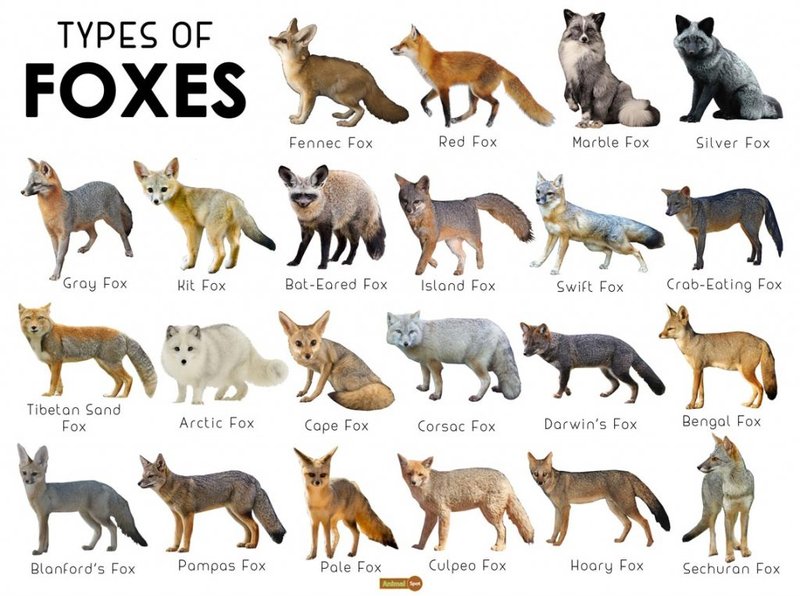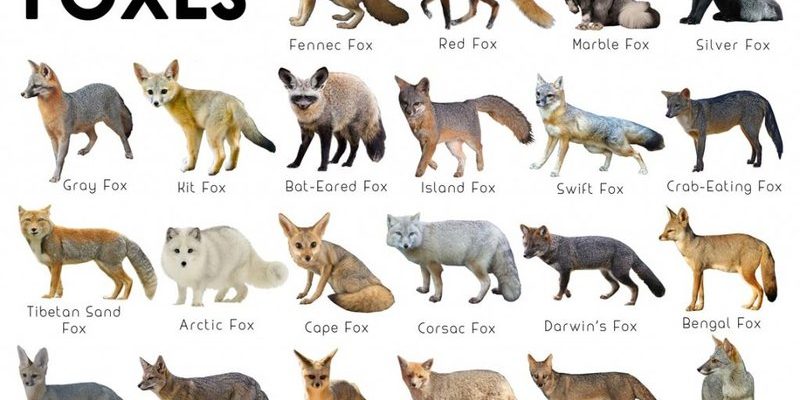
Now, you might find yourself wondering what exactly sets the red fox apart from its lookalikes. After all, understanding these differences can be as intriguing as watching a nature show unfold in your own backyard. In this article, we’ll explore ten animals that resemble the red fox, highlighting the unique attributes that make each one special. By the end, you’ll be well-versed in the wild world of canids and better equipped to tell these captivating creatures apart.
1. Gray Fox
While the gray fox might not have the striking orange hue of the red fox, it compensates with its unique appearance and adaptability. This medium-sized fox has a blend of grizzled gray fur with patches of reddish-brown. One of the most distinguishing features is its bushy tail, which has a black tip.
Here’s the thing: gray foxes are known for their climbing skills. Unlike their red counterparts, they can effortlessly scale trees. This remarkable ability allows them to escape predators and access food sources in a different way. So if you see a fox darting up a tree, it’s likely not a red fox!
You might also notice that gray foxes tend to be a bit smaller and slightly heavier than red foxes. They have a more delicate frame with a slimmer snout, making them look quite different overall.
2. Kit Fox
The kit fox is another fascinating relative that shares some traits with the red fox but is notably smaller. With its large ears and slender body, the kit fox has adapted to live in arid desert environments, primarily found in the western United States. Its fur is a pale, sandy color that helps it blend into the desert landscape.
One thing you’ll notice is that these little guys are masters of nocturnal hunting, primarily coming out at night. Their large ears aren’t just for show; they help them hear the faintest rustle of prey in the dark. If you spot a smaller fox with oversized ears darting about at twilight, you might just be looking at a kit fox!
In terms of size, the kit fox measures about the same as a domestic cat, making it much smaller than the red fox. Their slight build and darting movements give them a lively appearance, very different from the more robust red fox.
3. Arctic Fox
The arctic fox is a true survivor of the cold, with its thick, fluffy white fur that provides insulation against frigid temperatures. Unlike the red fox, the arctic fox thrives in the harsh environment of the Arctic tundra. During summer, its coat changes to a brownish hue, offering camouflage amid the tundra’s summer palette.
One of the most incredible adaptations of the arctic fox is its ability to change its fur. While a red fox typically retains its vibrant coat throughout the year, the arctic fox has this amazing skill to adapt, blending into its surroundings to stay hidden from predators.
If you’re ever lucky enough to see one, you’ll likely notice their shorter snouts and stocky builds—quite a departure from the sleek silhouette of the red fox. Their cute, rounded appearance adds to their charm, making them a favorite among wildlife watchers.
4. Fennec Fox
If you thought you had seen the cutest fox, meet the fennec fox! With its enormous ears and small body, this desert-dwelling fox has a look all its own. Its fur is a light sandy color, similar to the kit fox, but its prominent ears are what really catch your eye.
These big ears serve a practical purpose, helping to dissipate heat and keep the fennec fox cool in the scorching desert sun. You might find it fascinating that they also help in location hunting prey beneath the sand. Imagine having built-in radar for finding food—that’s what these clever creatures have!
While fennec foxes are smaller and cuter than red foxes, their unique features make them instantly recognizable. They weigh only about 2-3 pounds and have a playful personality that’s hard to resist.
5. Swift Fox
The swift fox is a smaller canid that closely resembles the red fox, but it’s less well-known. With a compact body and a light orange color, it’s easy to see the similarities. Swift foxes are usually found in the grasslands of North America and thrive in open habitats.
One distinguishing factor is their behavior. Swift foxes are social animals and often live in small family groups. They are incredibly agile and are known for their swift, darting movements, hence the name! If you see a sly little fox zipping through the fields, it’s likely a swift fox on the move.
In terms of size, swift foxes are considerably smaller, weighing about 5-7 pounds. Their shorter legs and smaller stature compared to the red fox can help you identify them quickly in the wild.
6. Corsac Fox
Native to the steppes of Central Asia, the corsac fox is often overlooked but shares notable similarities with the red fox. Their coat is typically a light grayish-brown, and they have a more slender build. Corsac foxes are primarily day-active, which is quite different from many other fox species.
You might find it interesting that corsac foxes are known for their curious nature. They can often be seen exploring their surroundings, which gives them a playful reputation. If you see a fox that seems to be more inquisitive than shy, it might just be a corsac fox.
They have shorter legs and a more elongated body compared to the red fox, helping them blend into their grassy habitats. Their slight size difference is an excellent way to tell them apart, along with their unique behaviors.
7. Blanford’s Fox
The Blanford’s fox is a small fox species found in the mountainous regions of Central Asia. With its thick, fluffy fur and bushy tail, it bears a resemblance to the red fox but stands out with its distinctive features and patterns.
This fox is a bit smaller than the red fox and has striking black markings on its face and ears, making it more recognizable. The fur color leans towards a grayish brown, which differs from the red fox’s vibrant coat.
Blanford’s foxes are known for their agility and skill in rocky terrains. If you ever spot a fox navigating steep cliffs and rocky outcrops, it may well be Blanford’s fox showing off its climbing prowess!
8. Sand Fox
The sand fox, similar to the fennec fox, is another small desert-dwelling canid found in North Africa. It’s known for its sandy-colored fur that provides excellent camouflage in its arid habitat. While it shares some traits with the red fox, such as its bushy tail, its size and coat color set it apart.
These foxes adapt gracefully to their surroundings, allowing them to thrive in the harsh dunes. They have slightly larger ears than a red fox, but they still look quite adorable, especially when they’re exploring their sandy home.
Their playful nature and unique adaptations to desert life make them fascinating animals. So if you ever find yourself in the Sahara, keep an eye out for these lively little creatures!
9. Tibetan Fox
The Tibetan fox is unique due to its stunning looks, characterized by its strikingly flat face and a beautifully thick coat. They often appear in hues of gray and cream, which helps them blend in with their mountainous habitat in the Tibetan plateau.
You might notice that their appearance differs significantly from the traditional idea of a fox. Their flattened face and broader nose give them a distinctive look, almost like a mix between a fox and a small dog.
Not only are these foxes visually different, but their hunting tactics are fascinating. They use a unique technique called “scent marking” to establish their territory, which is quite different from the red fox’s behavior.
10. Domestic Dog
Surprisingly, the domestic dog is part of the canid family, just like the red fox. While they’re often domesticated and trained for companionship, many breeds echo the appearance of the red fox, especially the Shiba Inu and Finnish Spitz. These breeds tend to sport similar reddish fur and bushy tails.
You might be surprised to learn that domestic dogs and red foxes share a common ancestor. This connection allows them to display similar behaviors, such as playfulness and social interaction.
Even though domestic dogs are much different in behavior and lifestyle, their resemblance to red foxes reminds us of their wild roots. So, keep an eye on the next fluffy pup you see; it may just remind you of a charming red fox!
In conclusion, the animal kingdom is full of intriguing canids that share similarities with the red fox. Each of these species, from the gray fox to the domestic dog, showcases unique traits that help them adapt to their environments. Understanding these differences can deepen our appreciation for the beauty and diversity of wildlife. So next time you’re out in nature, you’ll have a sharper eye for spotting those sneaky foxes and their lookalikes!

